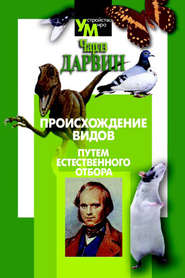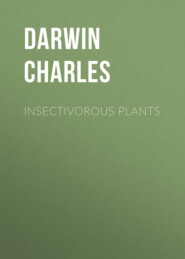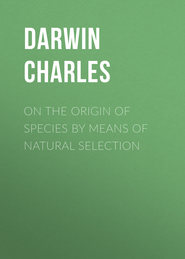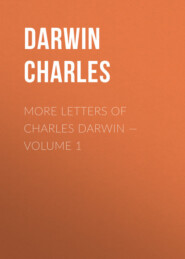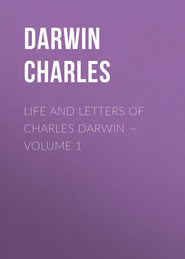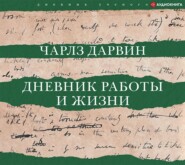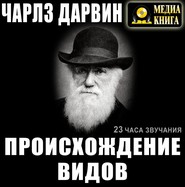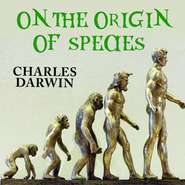По всем вопросам обращайтесь на: info@litportal.ru
(©) 2003-2024.
✖
The Origin of Species by Means of Natural Selection
Настройки чтения
Размер шрифта
Высота строк
Поля
DIFFERENTATION. – The separation or discrimination of parts or organs which in simpler forms of life are more or less united.
DIMORPHIC. – Having two distinct forms. – DIMORPHISM is the condition of the appearance of the same species under two dissimilar forms.
DIOECIOUS. – Having the organs of the sexes upon distinct individuals.
DIORITE. – A peculiar form of Greenstone.
DORSAL. – Of or belonging to the back.
EDENTATA. – A peculiar order of Quadrupeds, characterised by the absence of at least the middle incisor (front) teeth in both jaws. (Examples, the Sloths and Armadillos.)
ELYTRA. – The hardened fore-wings of Beetles, serving as sheaths for the membranous hind-wings, which constitute the true organs of flight.
EMBRYO. – The young animal undergoing development within the egg or womb.
EMBRYOLOGY. – The study of the development of the embryo.
ENDEMIC. – Peculiar to a given locality.
ENTOMOSTRACA. – A division of the class Crustacea, having all the segments of the body usually distinct, gills attached to the feet or organs of the mouth, and the feet fringed with fine hairs. They are generally of small size.
EOCENE. – The earliest of the three divisions of the Tertiary epoch of geologists. Rocks of this age contain a small proportion of shells identical with species now living.
EPHEMEROUS INSECTS. – Insects allied to the May-fly.
FAUNA. – The totality of the animals naturally inhabiting a certain country or region, or which have lived during a given geological period.
FELIDAE. – The Cat-family.
FERAL. – Having become wild from a state of cultivation or domestication.
FLORA. – The totality of the plants growing naturally in a country, or during a given geological period.
FLORETS. – Flowers imperfectly developed in some respects, and collected into a dense spike or head, as in the Grasses, the Dandelion, etc.
FOETAL. – Of or belonging to the foetus, or embryo in course of development.
FORAMINIFERA. – A class of animals of very low organisation and generally of small size, having a jelly-like body, from the surface of which delicate filaments can be given off and retracted for the prehension of external objects, and having a calcareous or sandy shell, usually divided into chambers and perforated with small apertures.
FOSSILIFEROUS. – Containing fossils.
FOSSORIAL. – Having a faculty of digging. The Fossorial Hymenoptera are a group of Wasp-like Insects, which burrow in sandy soil to make nests for their young.
FRENUM (pl. FRENA). – A small band or fold of skin.
FUNGI (sing. FUNGUS). – A class of cellular plants, of which Mushrooms, Toadstools, and Moulds, are familiar examples.
FURCULA. – The forked bone formed by the union of the collar-bones in many birds, such as the common Fowl.
GALLINACEOUS BIRDS. – An order of birds of which the common Fowl, Turkey, and Pheasant, are well-known examples.
GALLUS. – The genus of birds which includes the common Fowl.
GANGLION. – A swelling or knot from which nerves are given off as from a centre.
GANOID FISHES. – Fishes covered with peculiar enamelled bony scales. Most of them are extinct.
GERMINAL VESICLE. – A minute vesicle in the eggs of animals, from which the development of the embryo proceeds.
GLACIAL PERIOD. – A period of great cold and of enormous extension of ice upon the surface of the earth. It is believed that glacial periods have occurred repeatedly during the geological history of the earth, but the term is generally applied to the close of the Tertiary epoch, when nearly the whole of Europe was subjected to an arctic climate.
GLAND. – An organ which secretes or separates some peculiar product from the blood or sap of animals or plants.
GLOTTIS. – The opening of the windpipe into the oesophagus or gullet.
GNEISS. – A rock approaching granite in composition, but more or less laminated, and really produced by the alteration of a sedimentary deposit after its consolidation.
GRALLATORES. – The so-called wading-birds (storks, cranes, snipes, etc.), which are generally furnished with long legs, bare of feathers above the heel, and have no membranes between the toes.
GRANITE. – A rock consisting essentially of crystals of felspar and mica in a mass of quartz.
HABITAT. – The locality in which a plant or animal naturally lives.
HEMIPTERA. – An order or sub-order of insects, characterised by the possession of a jointed beak or rostrum, and by having the fore-wings horny in the basal portion and membranous at the extremity, where they cross each other. This group includes the various species of bugs.
HERMAPHRODITE. – Possessing the organs of both sexes.
HOMOLOGY. – That relation between parts which results from their development from corresponding embryonic parts, either in different animals, as in the case of the arm of man, the fore-leg of a quadruped, and the wing of a bird; or in the same individual, as in the case of the fore and hind legs in quadrupeds, and the segments or rings and their appendages of which the body of a worm, a centipede, etc., is composed. The latter is called serial homology. The parts which stand in such a relation to each other are said to be homologous, and one such part or organ is called the homologue of the other. In different plants the parts of the flower are homologous, and in general these parts are regarded as homologous with leaves.
HOMOPTERA. – An order or sub-order of insects having (like the Hemiptera) a jointed beak, but in which the fore-wings are either wholly membranous or wholly leathery, The Cicadae, frog-hoppers, and Aphides, are well-known examples.
HYBRID. – The offspring of the union of two distinct species.
HYMENOPTERA. – An order of insects possessing biting jaws and usually four membranous wings in which there are a few veins. Bees and wasps are familiar examples of this group.
HYPERTROPHIED. – Excessively developed.
ICHNEUMONIDAE. – A family of hymenopterous insects, the members of which lay their eggs in the bodies or eggs of other insects.
IMAGO. – The perfect (generally winged) reproductive state of an insect.
INDIGENES. – The aboriginal animal or vegetable inhabitants of a country or region.
INFLORESCENCE. – The mode of arrangement of the flowers of plants.
INFUSORIA. – A class of microscopic animalcules, so called from their having originally been observed in infusions of vegetable matters. They consist of a gelatinous material enclosed in a delicate membrane, the whole or part of which is furnished with short vibrating hairs (called cilia), by means of which the animalcules swim through the water or convey the minute particles of their food to the orifice of the mouth.
INSECTIVOROUS. – Feeding on insects.






